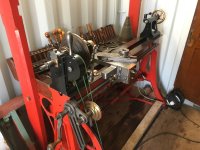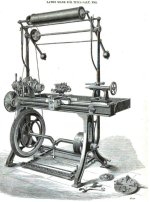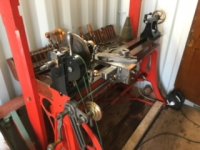You are using an out of date browser. It may not display this or other websites correctly.
You should upgrade or use an alternative browser.
You should upgrade or use an alternative browser.
Lathe designed in Jersey but made in London
- Thread starter Bodger
- Start date
- Replies 37
- Views 1,395
Maltesehunter
Cast Iron
- Joined
- Apr 25, 2008
- Location
- Elk Grove, CA
Thanks for posting pictures. Is there any way you can upload bigger ones so we can zoom in?
L Vanice
Diamond
- Joined
- Feb 8, 2006
- Location
- Fort Wayne, IN
Got a Windows computer? Hold the Ctrl key while tapping the + key several times to enlarge the image on your screen. Ctrl and - will shrink the image and Ctrl and 0 (zero) will return the screen to normal. At some point, the image will get fuzzy when enlarged greatly, but it worked on these lathe pictures OK for me.Thanks for posting pictures. Is there any way you can upload bigger ones so we can zoom in?
You can also save the picture to your own computer with whatever name and file location you like. Then you can use a photo editor to get a larger image on your screen.
Larry
Last edited:
Sorry, I think there may be a limit on the upload size? not sure how to get around that without having a link to elsewhere/third party picture host.Thanks for posting pictures. Is there any way you can upload bigger ones so we can zoom in?
Any pic's are good . We all live vicariously trough every poster with a new antique machine . I myself like to see how different factories made their versions of these machine's .
when your through learning , your through .
thanks
animal
when your through learning , your through .
thanks
animal
Last edited:
L Vanice
Diamond
- Joined
- Feb 8, 2006
- Location
- Fort Wayne, IN
Yes the last software update did put a limit on picture file size instead of having the software automatically reduce the size. I am not sure what the limit is, but it might be around 1 MB. I keep my camera set on a high resolution that makes the file around 5 to 7 MB. To post here, I put the picture in the Microsoft Photos program on my Windows computer and resize to about 2000 wide. That gets a pretty large image here, with a file size around 500 KB.Sorry, I think there may be a limit on the upload size? not sure how to get around that without having a link to elsewhere/third party picture host.
Larry
cyanidekid
Titanium
- Joined
- Jun 4, 2016
- Location
- Brooklyn NYC
wow, looks good. just amazing to see the Salt name engraved in the dividing plate, thanks. with this much history, perhaps consider contacting a museum for assistance. I have no idea which one would be a good candidate, but there must be others on here who can help. one has already been mentioned. where are you located?Current progress, lots still to do…
Yes the last software update did put a limit on picture file size instead of having the software automatically reduce the size. I am not sure what the limit is, but it might be around 1 MB. I keep my camera set on a high resolution that makes the file around 5 to 7 MB. To post here, I put the picture in the Microsoft Photos program on my Windows computer and resize to about 2000 wide. That gets a pretty large image here, with a file size around 500 KB.
Larry

L Vanice
Diamond
- Joined
- Feb 8, 2006
- Location
- Fort Wayne, IN
Good show. I did the "open image in new tab" and then did the Ctrl + + + + trick and never lost any detail. I could see you used modern urethane round belting and even saw one of the belt welds. This is not a rose engine lathe (no rocking headstock with wavy pattern discs). So I wonder if there is still a pile of fancy accessories like an oval chuck, epicycloidal cutting frame or chuck or spherical chuck. Those ivory and blackwood goodies that Salt turned surely needed some of the ornamental trick stuff.
Here is the engraving made from photos of the Salt lathe in 1870 or slightly earlier. I see a number of differences from its present state. Mr. Salt probably had improvements made over the years he used the lathe. Perhaps some parts got lost and replaced over the years since. The cut shows a fancy chuck in place, but I have forgotten what it is called. And some kind of trick attachment is shown on the slide rest behind the plain turning tool.

Larry
Here is the engraving made from photos of the Salt lathe in 1870 or slightly earlier. I see a number of differences from its present state. Mr. Salt probably had improvements made over the years he used the lathe. Perhaps some parts got lost and replaced over the years since. The cut shows a fancy chuck in place, but I have forgotten what it is called. And some kind of trick attachment is shown on the slide rest behind the plain turning tool.

Larry
Hi Larry,Good show. I did the "open image in new tab" and then did the Ctrl + + + + trick and never lost any detail. I could see you used modern urethane round belting and even saw one of the belt welds. This is not a rose engine lathe (no rocking headstock with wavy pattern discs). So I wonder if there is still a pile of fancy accessories like an oval chuck, epicycloidal cutting frame or chuck or spherical chuck. Those ivory and blackwood goodies that Salt turned surely needed some of the ornamental trick stuff.
Here is the engraving made from photos of the Salt lathe in 1870 or slightly earlier. I see a number of differences from its present state. Mr. Salt probably had improvements made over the years he used the lathe. Perhaps some parts got lost and replaced over the years since. The cut shows a fancy chuck in place, but I have forgotten what it is called. And some kind of trick attachment is shown on the slide rest behind the plain turning tool.
View attachment 383956
Larry
Yes well noted there are some differences, my opinion on that is that when Salt started to use the lathe he increased the stability by moving the RH leg to the end of the bed, there are tapped holes in the same position as the engraving still present for the cast A frame. This would mean the overhead and the crank would need to be changed to suit too. There are a variety of accessories and chucks with the lathe, but I think the possibility of taking curvilinear cuts through the gearbox probably aided the ability to created some of his pieces.
Thanks for the larger pic . So the saddle , carriage & apron except for the front cover are all one casting ? I finally got a chance to open the link that had all the history & pics . How did the owner ever get anything done , he must have spent half his time just looking for & deciding which tool / attachment he was going to use . This lathe with accompanying bits must have been his pride & joy . I know next to my family it would sure be mine .
thanks
animal
thanks
animal
Last edited:
Hi, no not quite, the saddle has a number of removable pieces to facilitate assembly on the bed and around the leadscrew, it’s some tidy/precision engineering for the year and using the tools available at the time!
I’ve often wondered the same, it would be great if I could get a brain upgrade…
I’ve often wondered the same, it would be great if I could get a brain upgrade…
Asquith
Diamond
- Joined
- Mar 3, 2005
- Location
- Somerset, UK
Thanks for the high resolution photo. I can even see the punch marks on the edge of the slot on the gear cluster’s banjo.
It’s a rare treat to find an intriguing machine in an old publication, and be able to get our hands on it, by proxy!
Nicely-made cranks. And everything else!
There are some features I don’t understand:-
1. Main spindle – what are the two face gears for? Reversing?
2. Compound slide rest – what are the gear teeth on the swivel base for? Spherical turning?
3. Apron – four square ended spindles – what are they all for? Perhaps something to do with the various traversing, angular and curvilinear cuts mentioned in the 1870 article?
Two levers on side of apron – what is the top one for?
I assume that the lower one engages a detent with the teeth on the bronze bush, thereby stopping it revolving and engaging the leadscrew with the carriage. It looks as though the nut is split and provided with a clamp to squeeze it and reduce backlash?
4. Base of tailstock – D-shaped steel piece?
It’s a rare treat to find an intriguing machine in an old publication, and be able to get our hands on it, by proxy!
Nicely-made cranks. And everything else!
There are some features I don’t understand:-
1. Main spindle – what are the two face gears for? Reversing?
2. Compound slide rest – what are the gear teeth on the swivel base for? Spherical turning?
3. Apron – four square ended spindles – what are they all for? Perhaps something to do with the various traversing, angular and curvilinear cuts mentioned in the 1870 article?
Two levers on side of apron – what is the top one for?
I assume that the lower one engages a detent with the teeth on the bronze bush, thereby stopping it revolving and engaging the leadscrew with the carriage. It looks as though the nut is split and provided with a clamp to squeeze it and reduce backlash?
4. Base of tailstock – D-shaped steel piece?
Last edited:
tonylathes
Aluminum
- Joined
- Oct 31, 2009
- Location
- UK
Hello, What a wonderful find - and this is, I feel, a very important English artifact and deserves wider coverage. I run the machine Tool Archive at http://www.lathes.co.uk/page21.html and http://www.lathes.co.uk/ and I'd love to be able to view the lathe and give it a prominent feature it. Would you be kind enough to phone me on 01298-872874 and discuss this? Or, email: [email protected] My thanks, Tony Griffiths.View attachment 383806View attachment 383807View attachment 383808View attachment 383809
Tailstock bore finish before cleaning!
View attachment 383811
View attachment 383810
Original labelled up tools
Thanks for the high resolution photo. I can even see the punch marks on the edge of the slot on the gear cluster’s banjo.
It’s a rare treat to find an intriguing machine in an old publication, and be able to get our hands on it, by proxy!
Nicely-made cranks. And everything else!
There are some features I don’t understand:-
1. Main spindle – what are the two face gears for? Reversing?
2. Compound slide rest – what are the gear teeth on the swivel base for? Spherical turning?
3. Apron – four square ended spindles – what are they all for? Perhaps something to do with the various traversing, angular and curvilinear cuts mentioned in the 1870 article?
Two levers on side of apron – what is the top one for?
I assume that the lower one engages a detent with the teeth on the bronze bush, thereby stopping it revolving and engaging the leadscrew with the carriage. It looks as though the nut is split and provided with a clamp to squeeze it and reduce backlash?
4. Base of tailstock – D-shaped steel piece?
Hi, Il try my best to answer your questions but please bare in mind I am also familiarising myself with the lathe and the memory is a little rusty since I last found time to work on it.
1. The vertical lever on the spindle engages drive form the spindle to the pulley/leadscrew either, FWD, N or REV from tumbler gears.
2. Yes, the gear teeth are driven by a gear in the centre axis of the compound slide.
3. The 4 square heads you refer to are as follows, surfacing movement, spherical movement, carriage fixing screw and carriage traverse. A square headed handle allows the user to operate manually these features or you can engage one or both of the surfacing/spherical levers or the carriage traverse by locking the teeth as you suggest. The split nut is actually the drive to the gearbox and clamps around the leadscrew to provide motion, (please see the engraving and you will see the clamp is up at the spindle end of the bed).
4. I believe these are carriage stops as they are on both the headstock and the tailstock and slide out some 10" id say at a guess.
Hello, What a wonderful find - and this is, I feel, a very important English artifact and deserves wider coverage. I run the machine Tool Archive at http://www.lathes.co.uk/page21.html and http://www.lathes.co.uk/ and I'd love to be able to view the lathe and give it a prominent feature it. Would you be kind enough to phone me on 01298-872874 and discuss this? Or, email: [email protected] My thanks, Tony Griffiths.
Hi Tony,
Many thanks for your reply, I am familiar with your excellent site as a go to place for resources/manuals etc. Unfortunately at the moment I am rather busy with other projects/work and play time has had to be 'shelved' for the time being, however when I return the plan is indeed to document the lathe and its functions etc once i've had a chance to figure them out that is!
L Vanice
Diamond
- Joined
- Feb 8, 2006
- Location
- Fort Wayne, IN
In the early 1970's, I bought an amazing book from an antique dealer who was doing an antique show in my little city. It was a leather bound hand written instruction book from Holtzappfel explaining the use of their epicycloidal cutting frame with gear tables and ink drawings. A cutting frame is a sort of belt-driven (from the overhead) milling attachment for a lathe slide rest. Even better, it had the book plate of the original owner, Sir David Lionel Salomons, Bart. (1851-1925). I later found he was a wealthy and very intelligent and talented man known for having around 60,000 tools and some extremely valuable watches. His home and shop was electrified in the 1870's, quite early for such an achievement, and he did the engineering. Anyway, on my third trip to London, I met a man with two rose engine lathes and told him about my book. On my fourth trip to London, I got to see the two rose engines (Holtzappfel and/or Evans, I think) in the front room of his house and left the book there.
https://en.wikipedia.org/wiki/David_Lionel_Goldsmid-Stern-Salomons
Salomons' house: https://en.wikipedia.org/wiki/Salomons_Museum Note there exists a catalog of the library in 1903, which likely listed the lathe books, unless they were out in the shop.
Sir David's only heir, a son, died in 1915 (WWI), ten years before his father. The fate of the tools was probably one heck of an auction. No telling how that book got to Fort Wayne, IN.
I mention this book because I am sure the designer of Mr. Salt's unique lathe must have provided a similar instruction manual, and I bet it was hand written and nicely bound. And bookplates were to be expected in a wealthy man's library. A unique lathe would imply that the operator could not be entirely familiar with it upon first use, so instructions would be imperative.
Larry
https://en.wikipedia.org/wiki/David_Lionel_Goldsmid-Stern-Salomons
Salomons' house: https://en.wikipedia.org/wiki/Salomons_Museum Note there exists a catalog of the library in 1903, which likely listed the lathe books, unless they were out in the shop.
Sir David's only heir, a son, died in 1915 (WWI), ten years before his father. The fate of the tools was probably one heck of an auction. No telling how that book got to Fort Wayne, IN.
I mention this book because I am sure the designer of Mr. Salt's unique lathe must have provided a similar instruction manual, and I bet it was hand written and nicely bound. And bookplates were to be expected in a wealthy man's library. A unique lathe would imply that the operator could not be entirely familiar with it upon first use, so instructions would be imperative.
Larry
Last edited:
L Vanice
Diamond
- Joined
- Feb 8, 2006
- Location
- Fort Wayne, IN
Perhaps more accessible to a UK resident would be the Society of Ornamental Turners in England. I think they would welcome the owner of the Salt lathe with open and envious arms.monkeyiow, Are you familiar with the Plumier Foundation in Port Chester, New York? It is an organization with the mission of preserving Ornamental Lathes and the skills to use them. They have a wonderful collection including Holtzapffel #1636, the most expensive and complete rose engine the company ever made. In addition their library contains most books written on the subject and be of a lot of help in your restoration. https://plumier.org/
The Society of Ornamental Turners
The Society of Ornamental Turners
The Society of Ornamental Turners
Larry
Similar threads
- Replies
- 3
- Views
- 521
- Replies
- 10
- Views
- 1K
- Replies
- 21
- Views
- 1K
- Replies
- 4
- Views
- 497


